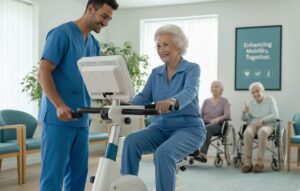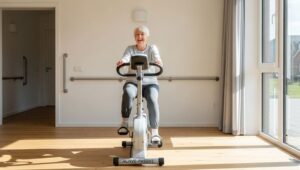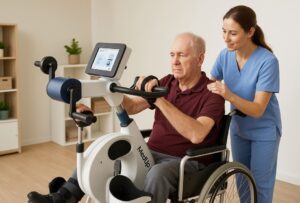
While exercise is an important part of a healthy lifestyle, it’s even more important for people struggling with a degenerative disease like Parkinson’s. The physical effects of this brain disorder can be quite disruptive but studies have shown that incorporating regular exercise into a patient’s routine can help mitigate some of these symptoms, as well as offer a number of other benefits as their disease progresses.
Benefits of exercise for Parkinson’s patients
Incorporating regular exercise into a daily routine can help those with Parkinson’s disease in a number of different ways, both physically and mentally. Although it might be difficult to include physical activity on a daily basis, there is good reason to encourage a short walk, some time on a treadmill or the use of an active passive trainer.
Some of the top benefits of regular exercise for Parkinson’s patients may include:
- Reduced motor symptoms such as tremors, rigidity, weakness and fatigue
- Improves balance issues and slowed movement
- Improves endurance
- Cognitive function may be maintained or improved
- Gait problems can be reduced
- Can maintain or improve cardiac health
Incorporating an active-passive trainer
As long as a patient with Parkinson’s is able to take on physical activity of their own volition it’s ideal for them to participate in some sort of activity daily. However, as the disease progresses it becomes much more difficult for them to maintain any sort of regular activity. At this point, the use of an active-passive trainer can be the preferred solution.
An active passive trainer uses a motor to help offset the muscle strength of the user allowing them to use as much of their strength as they are able to, without pushing so far as to cause injury. With built-in passive and active assist modes the user is able to fully benefit from range of motion exercises, even if their strength only allows for partial movement completion.
Helps perform all basic exercise types
A passive-active trainer incorporates all basic exercise types in one portable and easy to use unit. The sturdy base and multi-mode interface make it simple and safe to use, even without supervision. Four training modes allow the user to work on improving their balance, strength, endurance and flexibility, all important parts of a beneficial exercise routine.
As the disease progresses or when the patient has more bad days, they may find that they struggle with completing the cycling motions. The ability to automatically switch between training modes to offer more or less assistance can help the user to keep up with their exercise, without making them feel like they’re experiencing setbacks.
Consistent training is important
As with many situations that involve physical activity, the results may not be seen immediately. However, maintaining an exercise routine for an extended period of time can result in significant benefits for most Parkinson’s patients. Studies have shown that patients who adopt a routine that includes low intensity stretching, training and resistance exercises for 6 months or more are more apt to improve their gait speed and quality, cardiovascular fitness, muscle strength and motor skills.
Exercise therapy is an essential part of the process
Anytime someone is diagnosed with a life-altering illness or disease, the natural response is to look into ways to help them throughout their process. Luckily, when it comes to Parkinson’s disease, many studies have shown that a low intensity exercise routine can have noticeable benefits for most patients. This knowledge combined with the convenience of an active-passive cycle trainer can help patients and their loved ones make a plan for how to handle their new circumstances.
While it’s always suggested to consult with a doctor before beginning a new exercise routine, many doctors and physical therapists will support the use of an active-passive cycle trainer at home. Built-in safety features and a stable base make the MedUpV2 a top choice for an in-home trainer and the perfect tool for someone going through Parkinson’s disease.




